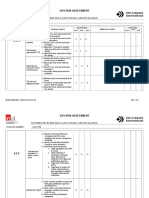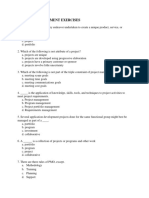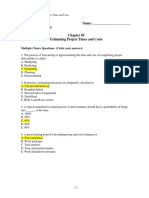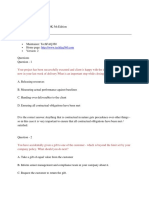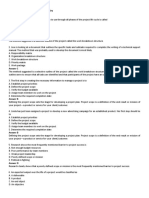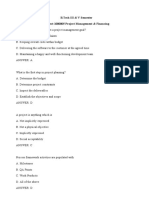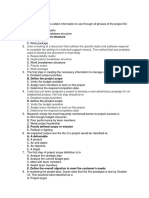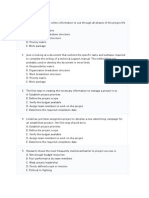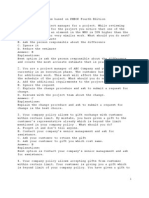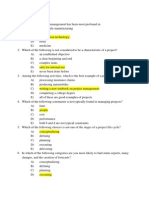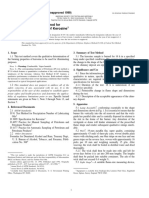Time
Time
Uploaded by
nsadnanCopyright:
Available Formats
Time
Time
Uploaded by
nsadnanCopyright
Available Formats
Share this document
Did you find this document useful?
Is this content inappropriate?
Copyright:
Available Formats
Time
Time
Uploaded by
nsadnanCopyright:
Available Formats
Home page: http://www.techfaq360.
com
Time. Resources: Based on PMBOK 5th Edition
Questions Question - 1 An activity has an Early Start(ES) of 5 days and Late Start of 16 days.What is the activity's float ? A. 11 days B. 21 days C. 5 days D. 16 days
A is the correct answer. A is the correct answer. Activity float = Late Start - Early Start = 16-5 = 11 days
Question - 2 An activity has an Early Finish(EF) of 5 days and Late Finish(LF) of 16 days.What is activity's float ? A. 11 days B. 21 days
C. 5 days D. 16 days
A is the correct answer. A is the correct answer. Activity float = Late Finish - Early Finish = 165 = 11 days
Question - 3 Which of the following is NOT an activity in Define Activities ? A. Decomposition B. An activity list from a previous project C. Progressive elaboration planning D. Create project charter
D is the correct answer. D is the correct answer. Create project charter is an activity in initiation phase.
Question - 4 As a project manager of a project , you have just completed Schedule network diagram. What should you do NEXT in time management ? A. Estimate Activity Resources B. Sequence Activities C. Estimate Activity Durations D. Develop Schedule
A is the correct answer. A is the correct answer. Schedule network diagram is an output of Sequence Activities, NEXT process is Estimate Activity Resources.
Question - 5 As a project manager of a project , you have just completed Schedule network diagram. Which of the following time management activities have you completed? A. Estimate Activity Resources B. Sequence Activities C. Estimate Activity Durations D. Develop Schedule
B is the correct answer. B is the correct answer. Schedule network diagram is an output of Sequence Activities.
Question - 6 Project Team has created sub plans for each activity in project plan. These plans are called : A. resource plans B. activity plans C. sub plans D. management plans
D is the correct answer. D is the correct answer. These plans are called management plans.
Question - 7
Your project activity float is negative 10. What is your course of action ? A. add more resources B. ask more time to complete the project C. use less experienced team members D. Ignore It.
A is the correct answer. A is the correct answer. Negative activity float means your project is behind. Add more resource is best option.
Question - 8 In which of the following situation network diagram is better than bar chart ? A. to show inter dependecies between activities B. analysis of schedule progress C. analysis of WBS D. analysis of project plan
A is the correct answer. A is the correct answer. network diagram is best to show Interdependencies between activities.
Question - 9 To facilitate analysis of schedule progress, it is convenient to use a : A. comparison bar chart B. network diagram
C. pie chart D. all of the above
A is the correct answer. A is the correct answer. To facilitate analysis of schedule progress, it is convenient to use a comparison bar chart, which displays two bars for each schedule activity.
Question - 10 Risk probability and impact Assessment, Risk Categorization are done during: A. qualitative risk analysis B. quantitative risk analysis C. Risk management plan D. Risk identification
A is the correct answer. A is the correct answer. Risk probability and impact Assessment, Risk Categorization are done during qualitative risk analysis.
Question - 11 A Heuristics is best described as : A. thumb rule. B. activity diagram. C. workaround. D. control tool.
A is the correct answer. A is the correct answer. Heuristics is thumb rule. Examples are cost per square feet etc.
Question - 12 Comparing target dates with the actual or forecast start and finish dates is called : A. Variance Analysis B. Earned Value C. Progress Reporting D. Crashing
A is the correct answer. A is the correct answer. Variance Analysis : Comparing target dates with the actual or forecast start and finish dates.
Question - 13 Total activity float is the amount of time : A. that can be delayed without delaying project completion date. B. that can be delayed without delaying project. C. delayed for indefinite time. D. Not related with project.
A is the correct answer. A is the correct answer. Total activity float is the amount of time that can be delayed without delaying project completion date.
Question - 14
You are the project manager of a software project. Your team member want to make technical changes to an activity which will add more time to that activity. What should you do ? A. Check if the activity is on critical path B. Allow team members to change the activity C. Report to senior management D. Ignore change in activities.
A is the correct answer. A is the correct answer. Check the activity if it is on critical path is the best option.
Question - 15 You are the project manager of a software project. You have just analyzed activity sequences, durations, resource requirements , schedule constraints and created project schedule. The above task belongs to which process? A. Define Activities B. Sequence Activities C. Develop Schedule D. Control Schedule
C is the correct answer. C is the correct answer. analyzing activity sequences, durations, resource requirements , schedule constraints and creating project schedule belongs to Develop Schedule process.
Question - 16 A weighted average duration estimate to calculate duration is called :
A. PERT B. CPM C. GERT D. pareto chart
A is the correct answer. A is the correct answer. Program Evaluation and Review Technique (PERT): Uses a weighted average duration estimate to calculate duration. Uses the probability of an estimate's accuracy. Expected Time = (Low + 4*Medium + High) / 6
Question - 17 Identifying and documenting the activities that must be performed to produce the project deliverables is called : A. Estimate Activity Resources B. Sequence Activities C. Estimate Activity Durations D. Define Activities
D is the correct answer. D is the correct answer. Identify and documenting the activities that must be performed to produce the project deliverables is called Define Activities .
Question - 18 An activity which is on critical path is delayed. What should you do ? A. Compress the schedule B. Scope cut
C. Inform customer about delay D. Deliver uncompleted activity
A is the correct answer. A is the correct answer. Compress the schedule is the best option.
Question - 19 A project has three critical paths. How does this affect the project ? A. It increases project risk. B. It needs more resources. C. It needs more time. D. It costs more.
A is the correct answer. A is the correct answer. It increases project risk.
Question - 20 Estimating the number of work periods likely to be needed to complete each activity is called : A. Estimate Activity Resources B. Sequence Activities C. Estimate Activity Durations D. Define Activities
C is the correct answer. C is the correct answer. Estimating the number of work periods likely to be needed to complete each activity is called Estimate Activity Durations .
Question - 21 One activity will be delayed three weeks and that will affect the project completion date. Who will approve the change ? A. Change control board B. project manager C. Senior management D. Team member
A is the correct answer. A is the correct answer.
Question - 22 Which statement is true about Project Time Management ? A. Project Time Management consists of processes required to ensure timely completion of the project. B. Project Time Management is related to creating Work Break Down Structure. C. Project Time Management is related to create project charter. D. All of the above
A is the correct answer. A is the correct answer. Project Time Management consists of the "processes required to accomplish timely completion of the project."
Question - 23 Which document is required to start Project Time Management process ?
A. SOW B. WBS C. Scope Statement D. All of the above
C is the correct answer. C is the correct answer. Scope Statement is required to start Project Time Management process . The Scope Statement is the base for all decisions.
Question - 24 Decomposition of the Scope Statement results in _____ ?. A. Project plan B. WBS C. Business plans D. SOW
B is the correct answer. B is the correct answer. The WBS defines all activities you will need to do in order to successfully complete the project.
Question - 25 You are the project manager of a project and you break down the WBS into smaller _______ to get detail so that you can construct a schedule. A. Work packages B. Sections C. Issues
D. None
A is the correct answer. A is the correct answer. The work packages gives you the detail you need to construct a schedule.
Question - 26 Project Time Management includes _________ ? A. Define Activities B. Sequence Activities C. Control Schedule D. All of the above
D is the correct answer. D is the correct answer. The process areas listed for Project Time Management in the PMBOK are: Define Activities, Sequence Activities, Estimate Activity Resources, Estimate Activity Durations, Develop Schedule, and Control Schedule.
Question - 27 Which is the first process in Time Management ? A. Define Activities B. Sequence Activities C. Estimate Activity Durations D. Develop Schedule
A is the correct answer. A is the correct answer. The process areas listed for Project Time
Management in the PMBOK are: Define Activities, Sequence Activities, Estimate Activity Resources, Estimate Activity Durations, Develop Schedule, and Control Schedule. Define Activities is the first process in Time Management.
Question - 28 Which of the following are inputs of Define Activities ? A. Organizational Process Assets B. Scope baseline C. Enterprise environmental factors D. All of the above
D is the correct answer. D is the correct answer. Inputs of Define Activities : Scope baseline, Organizational Process Assets and Enterprise environmental factors
Question - 29 Which of the following are the outputs of Define Activities ? A. Activity list B. Activity Attributes C. Milestone List D. All of the above
D is the correct answer. D is the correct answer. outputs of Define Activities : Activity list, Activity Attributes and Milestone List. PMBOK Page no 142
Question - 30
You are the project manager for the Project. You are decomposing during Define Activities, the final output is ______? A. Deliverables B. Work packages C. Activity list D. Milestone List
C is the correct answer. C is the correct answer. Activity list - A list of all the activities that will be performed on the project and a description of each.
Question - 31 You are the project manager for a large Project. You are identifying and documenting relationship among the project activities. This process is called ______? A. Define Activities B. Sequence Activities C. Develop Schedule D. Control Schedule
B is the correct answer. B is the correct answer. Sequence Activities - identifying and documenting relationship among the project activities.
Question - 32 You are the project manager for a large Project. You are identifying external dependencies for the activities with management team. Identifying external dependencies are done in ______?
A. Define Activities B. Sequence Activities C. Develop Schedule D. Control Schedule
B is the correct answer. B is the correct answer. Identifying external dependencies are done in Sequence Activities.
Question - 33 Development activities of a software project are dependent on a third party vendor, This is called ______. A. external dependencies B. internal dependencies C. Discretionary dependencies D. All of the above
A is the correct answer. A is the correct answer. external dependencies are usually outside of project team control. PMPBOK Page no 171.
Question - 34 Discretionary dependencies are identified during __________. A. Define Activities B. Sequence Activities C. Develop Schedule
D. Control Schedule
B is the correct answer. B is the correct answer. Discretionary dependencies are identified during Sequence Activities process. PMPBOK Page no 171.
Question - 35 Resource Breakdown Structure is an output of __________ process. A. Develop Schedule B. Estimate Activity Resources C. Estimate Activity Durations D. Control Schedule
B is the correct answer. B is the correct answer. Resource Breakdown Structure is an output of Estimate Activity Resources process. PMPBOK Page no 162.
Question - 36 You are the project manager for a large Project. You have identified and documented relationship among the project activities and created project schedule network diagram. What is your NEXT step ? A. Define Activities B. Sequence Activities C. Develop Schedule D. Control Schedule
C is the correct answer. C is the correct answer. project schedule network diagram is input to Develop Schedule. PMBOK Page no 142.
Question - 37 You are the project manager for a large Project. You are currently busy with approximating number of work periods required to complete individual activities with estimated resources. Which of the following inputs do you need for this ? A. Activity List B. Activity resource requirements C. Resource Breakdown structure D. All of the above
C is the correct answer. C is the correct answer. Approximating number of work periods required to complete individual activities with estimated resources is done in Estimate Activity Duration process. Activity List,Activity resource requirements and Resource Breakdown structure are inputs of Estimate Activity Duration process. PMBOK Page no 142.
Question - 38 You are the project manager for a Project. You are updating the WBS during Define Activities, which is often called ________? A. Refinements B. Updates C. Activities D. Supporting detail
A is the correct answer. A is the correct answer. updating the WBS during Define Activities, is
often called Refinements. It occurs with riskier projects.
Question - 39 Which statement is true about Rolling Wave Planning ? A. Rolling wave planning is a form of progressive elaboration planning. B. Rolling Wave Planning where the work to be accomplished in the near term is planned in detail at a low level of WBS. C. Rolling Wave Planning where the work to be accomplished in the future work is planned at a higher level of WBS D. All of the above
D is the correct answer. D is the correct answer. Rolling Wave Planning : Rolling wave planning is a form of progressive elaboration planning. Rolling Wave Planning where the work to be accomplished in the near term is planned in detail at a low level of WBS. Rolling Wave Planning where the work to be accomplished in the future work is planned at a higher level of the WBS.
Question - 40 Which statement is true about Sequence Activities? A. Identifying and documenting interactivity logical relationships. B. As input list of activities, to put them into some sort of logical order, which is called Sequence Activities. C. Establishing the activity logic and the dependencies needed to create a realistic and achievable schedule. D. All of the above
D is the correct answer. D is the correct answer. Sequence Activities : Identifying and
documenting interactivity logical relationships. As input list of activities, to put them into some sort of logical order, which is called Sequence Activities. Establishing the activity logic and the dependencies needed to create a realistic and achievable schedule.
Question - 41 What are Milestones ? A. Significant events in the project life cycle B. Activities with durations C. Deliverables D. Project plan
A is the correct answer. A is the correct answer. Milestones - Events need to be part of the Sequence Activities to assure that the requirements for meeting the milestone (s) are met.
Question - 42 What are the types of dependencies that are used to define Activity Sequence ? A. Mandatory dependencies , Discretionary dependencies and External dependencies B. Mandatory dependencies and External dependencies C. Mandatory dependencies D. None
A is the correct answer. A is the correct answer. Types of dependencies used to define the Activity Sequence are : Mandatory dependencies , Discretionary dependencies and External dependencies . Mandatory dependencies (Hard logic) - Determined by the qualities of work to be done. Discretionary dependencies (Soft logic) - Defined by the project management team. External dependencies - Relationships between project activities and non-project activities.
Question - 43 Which statement is true ? A. Mandatory dependencies (Hard logic) - Determined by the qualities of work to be done. B. Discretionary dependencies (Soft logic) - Defined by the project management team. C. External dependencies - Relationships between project activities and non-project activities. D. All of the above
D is the correct answer. D is the correct answer. Types of dependencies used to define the Activity Sequence are : Mandatory dependencies , Discretionary dependencies and External dependencies . Mandatory dependencies (Hard logic) - Determined by the qualities of work to be done. Discretionary dependencies (Soft logic) - Defined by the project management team. External dependencies - Relationships between project activities and non-project activities.
Question - 44 Which statement is true ? A. Finish-to-start An activity must finish before the next activity begins. B. Finish-to-finish An activity must finish before the next activity can finish. C. Start-to-finish An activity must start before the next activity can finish. D. All of the above
D is the correct answer. D is the correct answer. Finish-to-start An activity must finish before the next activity begins. Finish-to-finish An activity must finish before the next activity can finish. Start-to-start An activity must start before the next activity can start. Start-to-finish An activity must start before the next activity can finish.
Question - 45 Which dependency is used by Microsoft Project Plan ? A. Finish-to-start B. Finish-to-finish C. Start-to-finish D. Start-to-start
A is the correct answer. A is the correct answer. Finish-to-start dependency is used by Microsoft Project Plan and Finish-to-start dependencies are the most commonly used in most projects.
Question - 46 Which statement is true about Finish-to-start activity ? A. An activity must finish before the next activity begins. B. An activity must finish before the next activity can finish. C. An activity must start before the next activity can start. D. An activity must start before the next activity can finish.
A is the correct answer. A is the correct answer. Finish-to-start An activity must finish before the next activity begins.
Question - 47 Starting a new task before finish the old one is an example of a __________ dependency. A. Start-to-finish
B. Finish-to-start C. Start-to-start D. All of the above
A is the correct answer. A is the correct answer. Start-to-finish An activity must start before the next activity can finish.
Question - 48 You are the project manager of a project and you have added some dummy activities to correctly show all logical relationships Which network diagramming method have you used ? A. ADM (Arrow Diagramming Method) B. Precedence Diagramming Method (PDM) C. PERT D. None
A is the correct answer. A is the correct answer. ADM (Arrow Diagramming Method) uses dummy activities to correctly show all logical relationships. Arrow Diagramming Method (ADM) uses arrows as activities, and nodes are used to connect and show dependencies. The Precedence Diagramming Method (PDM) uses boxes or nodes as activities and arrows as dependencies between the nodes.
Question - 49 Which statement is true about the Precedence Diagramming Method (PDM) ? A. Precedence Diagramming Method (PDM) uses boxes or nodes as activities and arrows as dependencies between the nodes.
B. PDM is also known as Activity On Nodes (AON). C. Both of the above are true D. None
C is the correct answer. C is the correct answer. The Precedence Diagramming Method (PDM) uses boxes or nodes as activities and arrows as dependencies between the nodes. PDM is also known as Activity On Nodes (AON).
Question - 50 Precedence Diagramming Method (PDM) is also known as _______? A. Activity On Node (AON) B. Activity On Arrow (AOA) C. Activity dependency D. All of the above
A is the correct answer. A is the correct answer. The Precedence Diagramming Method (PDM) uses boxes or nodes as activities and arrows as dependencies between the nodes. PDM is also known as Activity On Nodes (AON). ADM (Arrow Diagramming Method) is also known as Activity On Arrows (AOA).
Question - 51 ADM (Arrow Diagramming Method) also known as _______? A. Activity On Nodes (AON) B. Activity On Arrows (AOA) C. Activities dependencies
D. All of the above
B is the correct answer. B is the correct answer. The Precedence Diagramming Method (PDM) uses boxes or nodes as activities and arrows as dependencies between the nodes. PDM is also known as Activity On Nodes (AON). ADM (Arrow Diagramming Method) is also known as Activity On Arrows (AOA).
Question - 52 ADM stands for _________? A. Arrow Diagramming Method B. Arithmetic Diagramming Method C. All Diagramming Method D. All of the above
A is the correct answer. A is the correct answer. ADM (Arrow Diagramming Method)
Question - 53 PDM stands for ___________ ? A. Precedence Diagramming Method B. Process Diagramming Method C. Process Destination Method D. None
A is the correct answer. A is the correct answer. Precedence Diagramming Method (PDM).
Question - 54 Conditional branches are not used in __________ ? A. PDM B. ADM C. Both of the above D. GERT
C is the correct answer. C is the correct answer. Conditional branches are not used in PDM and ADM. GERT (Graphical Evaluation and Review Technique ) allows conditional branches and loops .
Question - 55 _____________ allows conditional branches and loops . A. GERT B. PDM C. ADM D. None of the above
A is the correct answer. A is the correct answer. Conditional branches are not used in PDM and ADM. GERT (Graphical Evaluation and Review Technique) allows conditional branches and loops .
Question - 56
Which diagram displays the project's activities and logical relationships ? A. Project network diagram B. Schedule diagram C. Project Plan diagram D. None
A is the correct answer. A is the correct answer. Project network diagram display's the project's activities and the logical relationships.
Question - 57 Who develops the project plan ? A. Only Project Manager B. Project Manager and team C. Sponsor D. Executive management
B is the correct answer. B is the correct answer. Project Manager and team develops the project plan .
Question - 58 Work periods between the finish of one activity and the start of another activity is called ______ ? A. Elapsed time (Delay). B. Estimation time.
C. Schedule. D. None
A is the correct answer. A is the correct answer. Elapsed time (Delay) - Work periods between the finish of one activity and the start of another activity.
Question - 59 In ________ phase the project schedule is developed A. Initiation B. Planning C. Execution D. None
B is the correct answer. B is the correct answer. In Planning phase the project schedule is developed
Question - 60 Top-down estimating is also called _______ estimating. A. Analogous B. Primary C. Organizational D. Simple
A is the correct answer. A is the correct answer. Top-down estimating is also called Analogous.
Question - 61 The three estimates are : Pessimistic (P) : 30 Most Likely (M) : 25 Optimistic (O) : 14 What is activity duration (PERT) ? A. 24 B. 20 C. 18 D. 32
A is the correct answer. A is the correct answer. Activity duration (PERT)= (P + 4M + O) / 6 then (30+4*25+14)/6 = 144/6 = 24
Question - 62 The Three estimates are : Pessimistic (P) : 30 Most Likely (M) : 25 Optimistic (O) : 14 What is Standard deviation ? A. 70% B. 60% C. 14% D. 26.6%
D is the correct answer. D is the correct answer. Standard deviation formula = (P - O) / 6 then (30-14)/6 = 70
Question - 63
Bar charts don't show _______. A. Dependencies B. Partial tasks C. Time constraints D. All of the above
D is the correct answer. D is the correct answer. Bar charts don't show Dependencies,Partial tasks and Time constraints. Bar Charts : Good to show progress and controlling tool, Does not display task dependencies, Does not help with project organization
Question - 64 Which statement is true about Milestone Charts ? A. Displays major events B. Used for management and customer reporting C. Both of the above are true D. None
C is the correct answer. C is the correct answer. Milestone Charts : Displays major events (like software coding completed), Used for management and customer reporting
Question - 65 Which statement is true about Network Diagram ? A. Displays task dependencies.
B. Provides for project control. C. Effective in planning and organizing the work. D. All of the above
D is the correct answer. D is the correct answer. Network Diagram : Displays task dependencies, Effective in planning and organizing the work, Provides for project control
Question - 66 If you are doing activities in parallel than it is called __________. A. Fast Tracking B. Compressed work C. Planning compression D. None
A is the correct answer. A is the correct answer. Fast Tracking may save some time but almost always results in rework.
Question - 67 If you are doing revisions and schedule updates than you are making changes to _________ ? A. Resources B. Start and Finish Dates C. Costs D. None of these
B is the correct answer. B is the correct answer. schedule updates means Start and Finish Date changes.
Question - 68 If you update the schedule of a project, the updates must be approved by the ______ . A. Project manager B. Project team C. Sponsor D. Not needed any approval.
C is the correct answer. C is the correct answer. Schedule updates must be approved by the Sponsor.
Question - 69 ________ are examples of corrective actions that can be taken. A. Tracking B. Crashing C. Both D. None
C is the correct answer. C is the correct answer. Tracking and Crashing are examples of corrective actions that can be taken.
Question - 70
The approved project schedule is called _____________ ? A. The Baseline schedule B. The Approved schedule. C. The Sponsored schedule. D. None
A is the correct answer. A is the correct answer. approved project schedule is called Baseline schedule.
Question - 71 Which statement is true about Critical Path Method (CPM) ? A. Calculates a single, deterministic early and late start and finish date for each activity. B. Used to determine which activities must be completed on time to avoid impacting the finish date of the project. C. Both are true D. None
C is the correct answer. C is the correct answer. Critical Path Method (CPM) - Calculates a single, deterministic early and late start and finish date for each activity, to be used to determine which activities must be completed on time to avoid impacting the finish date of the project.
Question - 72 Which statement is true ? A. Corrective action - Anything done to bring expected future schedule performance back in-line
with the project plan. B. Lessons learned - Documentation of the causes of variances, of the reasons the corrective actions were chosen, and of other information learned through controlling the schedule . C. Schedule updates - Modification to the schedule information used to manage the project. D. All of the above
D is the correct answer. D is the correct answer. Corrective action - Anything done to bring expected future schedule performance back in-line with the project plan. Lessons learned Documentation of the causes of variances, of the reasons the corrective actions that were chosen, and of other information learned through controlling the schedule . Schedule updates Modification to the schedule information used to manage the project. Schedule revisions Changes to the scheduled start and finish dates in the approved (or baselined) schedule.
Question - 73 Which statement is true about Variance Analysis ? A. Comparing target dates with actual start and finish dates to detect deviations and implement corrective solutions in case of delays. B. Defines the procedure for changing the project schedule. C. Involves subdividing the major project deliverables into smaller units. D. All of the above
A is the correct answer. A is the correct answer. Variance Analysis : comparing target dates with actual start and finish dates to detect deviations and implement corrective solutions in case of delays.
Question - 74 Which of the following is NOT an input to Develop Schedule ?
A. Activity List and Attributes. B. Activity Duration Estimates C. Project Management Plan D. Project Scope Statement
C is the correct answer. C is the correct answer. Project Management Plan is NOT an input to Develop Schedule. PMBOK Page no 142.
Question - 75 Which of the following is an output of Develop Schedule? A. Project schedule B. Schedule basline C. Project Document updates D. All of the above
D is the correct answer. D is the correct answer. Output of Develop Schedule : Project schedule,Schedule baseline , Schedule Data and Project Document updates. PMBOK Page no 142.
Question - 76 Which of the following is NOT an input for Estimate Activity Durations ? A. Activity duration estimates B. Activity list
C. Project Scope Statement D. Resource calendars
A is the correct answer. A is the correct answer. Activity duration estimates is the output of Estimate Activity Durations.
Question - 77 Which of the following are the inputs of Control Schedule ? A. Project schedule B. Work Performance data C. Project management plan D. All of the above
D is the correct answer. D is the correct answer. Inputs for Control Schedule : Project schedule, Work Performance data, Organizational Process Assets and Project management plan . PMBOK Page no 142.
Question - 78 Which of the following statement is true about Corrective action ? A. Anything done to bring expected future schedule performance back in-line with the project plan. B. Modification to the schedule information used to manage the project. C. Changes to the scheduled start and finish dates in the approved (or baselined) schedule. D. All of the above
A is the correct answer. A is the correct answer. Corrective action - Anything done to bring expected future schedule performance back in-line with the project plan. Schedule updates Modification to the schedule information used to manage the project. Schedule revisions Changes to the scheduled start and finish dates in the approved (or baselined) schedule.
Question - 79 Which of the following statement is true about Schedule revisions ? A. Anything done to bring expected future schedule performance back in-line with the project plan. B. Modification to the schedule information used to manage the project. C. Changes to the scheduled start and finish dates in the approved (or baselined) schedule. D. All of the above
C is the correct answer. C is the correct answer. Corrective action - Anything done to bring expected future schedule performance back in-line with the project plan. Schedule updates Modification to the schedule information used to manage the project. Schedule revisions Changes to the scheduled start and finish dates in the approved (or baselined) schedule.
Question - 80 Which of the following statement is true ? A. Reduce critical path - To fast track, shorten the duration of critical activities, or increase working hours. B. Crashing - Decreasing the total project duration with the least cost possible. C. Fast tracking - Doing activities in parallel that, normally, would be done in sequence. D. All of the above
D is the correct answer. D is the correct answer. All the definitions
Question - 81 Which of the following estimating technique is less costly and also less time consuming? A. Analogous estimating B. Parametric analysis C. Bottom up estimating D. Regression analysis
A is the correct answer. A is the correct answer. Analogous estimating is less accurate than other estimating methods. Analogous estimating is used in early phase of the project. Analogous estimating technique is less costly and less time consuming.
Question - 82 Which of the following statement is true about Resource leveling ? A. To fast track, shorten the duration of critical activities, or increase working hours. B. Decreasing the total project duration with the least cost possible. C. Doing activities in parallel that, normally, would be done in sequence. D. Reducing peak overloads by re-distributing allocations to activities with float .
D is the correct answer. Resource leveling : Reducing peak overloads by re-distributing allocations to activities with float .
You might also like
- Checklist For Pre Commissioning of CCTV SystemDocument1 pageChecklist For Pre Commissioning of CCTV Systemnsadnan70% (10)
- Checklist For Commissioning of CCTV SystemDocument2 pagesChecklist For Commissioning of CCTV Systemnsadnan70% (10)
- CCTV Testing and Commissioning Pre-Check List (ID 1506)Document1 pageCCTV Testing and Commissioning Pre-Check List (ID 1506)nsadnan80% (5)
- Risk Assessment - Distribution Board (DB) & Junction Box (JB) InstallationDocument6 pagesRisk Assessment - Distribution Board (DB) & Junction Box (JB) Installationnsadnan92% (12)
- Risk Assessment - Cable Pulling Laying, Glanding and Termination From RT Bay Outdoor Enclosure To RT Control BuildingDocument14 pagesRisk Assessment - Cable Pulling Laying, Glanding and Termination From RT Bay Outdoor Enclosure To RT Control Buildingnsadnan91% (82)
- Checklist For Access Control System InstallationDocument6 pagesChecklist For Access Control System Installationnsadnan75% (8)
- RISK ASSESSMENT - CG-4706-offloading The 40 Feet Container and Offloading The MaterialsDocument6 pagesRISK ASSESSMENT - CG-4706-offloading The 40 Feet Container and Offloading The Materialsnsadnan100% (6)
- Project Management ExercisesDocument29 pagesProject Management Exercisesanggelina irsandi100% (2)
- PMP Test NewDocument41 pagesPMP Test Newdsunte100% (1)
- Testing and Commissioning Pre-Check List (ID 1506)Document1 pageTesting and Commissioning Pre-Check List (ID 1506)nsadnan33% (3)
- Argus Model Engine Instruction ManualDocument4 pagesArgus Model Engine Instruction Manualmerrecoleca100% (1)
- Application Writ of ProhibitionDocument4 pagesApplication Writ of ProhibitionHunter DuntemanNo ratings yet
- Be It Certified PMI PMI-SP Free Questions DumpsDocument50 pagesBe It Certified PMI PMI-SP Free Questions DumpsKarim Mounir100% (6)
- CH 5Document10 pagesCH 5NatsuNo ratings yet
- BSIA Cyber Secure It January 2019Document16 pagesBSIA Cyber Secure It January 2019nsadnanNo ratings yet
- Risk Assessment - Aux. Relay Mounting & Pre-Internal Wiring of RT LCP-3Document4 pagesRisk Assessment - Aux. Relay Mounting & Pre-Internal Wiring of RT LCP-3nsadnanNo ratings yet
- Risk Assessment - Installation of Ventilation FanDocument6 pagesRisk Assessment - Installation of Ventilation Fannsadnan86% (7)
- Risk Assessment For GIS Preparation For HV Cable TestDocument11 pagesRisk Assessment For GIS Preparation For HV Cable Testnsadnan100% (3)
- Risk Assessment - 4500018082-Testing of Slab To Earth Resistance (Potrooms)Document3 pagesRisk Assessment - 4500018082-Testing of Slab To Earth Resistance (Potrooms)nsadnan50% (2)
- Risk Assessment - Ad-456 - Installation and Testing Vav Boxes & Controls in OmbDocument9 pagesRisk Assessment - Ad-456 - Installation and Testing Vav Boxes & Controls in Ombnsadnan100% (1)
- Risk Assessment - Aux. Relay Mounting & Pre-Internal Wiring of RT LCP-3Document4 pagesRisk Assessment - Aux. Relay Mounting & Pre-Internal Wiring of RT LCP-3nsadnanNo ratings yet
- CH 5 - Intercompany Transaction - InventoriesDocument14 pagesCH 5 - Intercompany Transaction - InventoriesMutia WardaniNo ratings yet
- Share Vesting Agreement - ZegalDocument6 pagesShare Vesting Agreement - ZegalAlan PetzoldNo ratings yet
- 02 PlanningDocument27 pages02 PlanningYannick KoffiNo ratings yet
- PMI-SP PMI Scheduling Professional Pmi-Sp: ExamDocument13 pagesPMI-SP PMI Scheduling Professional Pmi-Sp: ExamEdwin Barreto CallupeNo ratings yet
- Q & A Project Time ManagementDocument10 pagesQ & A Project Time ManagementmukhlisNo ratings yet
- PMP QuestionDocument84 pagesPMP Questionrashdan rosmanNo ratings yet
- Time Management Test1Document17 pagesTime Management Test1tkurasaNo ratings yet
- Time Management TestDocument16 pagesTime Management Testtkurasa100% (1)
- QuestionDocument343 pagesQuestionarun_sakre100% (1)
- Bozhan Tif ch05Document13 pagesBozhan Tif ch05Jimmi Singh100% (1)
- 04 Monitoring and ControlDocument11 pages04 Monitoring and ControlYannick KoffiNo ratings yet
- Test 03Document96 pagesTest 03peter hany100% (1)
- PMP Test 02 PDFDocument95 pagesPMP Test 02 PDFnajeeb.150100% (2)
- Cce Question Bank - 3 (75 Questions)Document19 pagesCce Question Bank - 3 (75 Questions)ThampooNo ratings yet
- Exam Questions PMPDocument13 pagesExam Questions PMPSandeep MaheyNo ratings yet
- Full Length Mock Test 01 - EditedDocument100 pagesFull Length Mock Test 01 - Editedmarks2much100% (1)
- Project ManagementDocument37 pagesProject ManagementNahom Asegid TeressaNo ratings yet
- PMP 6 Edition Questions & Answer: Page 1 of 15Document15 pagesPMP 6 Edition Questions & Answer: Page 1 of 15Prakash SelvarajNo ratings yet
- 0quiz CH 4-5 PDFDocument20 pages0quiz CH 4-5 PDFrajlaxmi1001No ratings yet
- 0quiz CH 4-5Document20 pages0quiz CH 4-5rajlaxmi1001100% (1)
- PSP P-2Document15 pagesPSP P-2Deejaay2010100% (1)
- Project Time Management: Practice ExamDocument8 pagesProject Time Management: Practice ExamTawanda KurasaNo ratings yet
- PMP Exam Questions With AnswersDocument35 pagesPMP Exam Questions With AnswersLeanwisdom100% (3)
- Question Bank 2022 (1) DHDFDocument59 pagesQuestion Bank 2022 (1) DHDFAbhishek KNo ratings yet
- PMP Exam Set A - Q1Document17 pagesPMP Exam Set A - Q1Rohit JhunjhunwalaNo ratings yet
- It Project Man 600 CA Test 2 McqsDocument32 pagesIt Project Man 600 CA Test 2 McqsOregolele Jesicca MasibiNo ratings yet
- MCQsDocument19 pagesMCQshoangduy7696No ratings yet
- Project Schedule ManagementDocument5 pagesProject Schedule Managementnifaruk77No ratings yet
- ch4 PDFDocument8 pagesch4 PDFNatsuNo ratings yet
- Exam Central PMP Part 1Document44 pagesExam Central PMP Part 1SachinNo ratings yet
- General Revision 1Document28 pagesGeneral Revision 1Deejaay2010No ratings yet
- Project ManagementDocument6 pagesProject ManagementdoannamphuocNo ratings yet
- Certchamp 200 PMP 4th Edition QuestionsDocument58 pagesCertchamp 200 PMP 4th Edition Questionstohema100% (1)
- Project Planning and ControlDocument11 pagesProject Planning and ControlPKyromitis0% (1)
- PMP Sample QuestionsDocument46 pagesPMP Sample QuestionsMarwan Nasution100% (1)
- PM - FINAL - ONLINE (1) .Docx CEVAPLARIDocument10 pagesPM - FINAL - ONLINE (1) .Docx CEVAPLARIGulsah AltunNo ratings yet
- Question Set 3Document4 pagesQuestion Set 3Najmul HussainNo ratings yet
- PMP Time Management AnswersDocument5 pagesPMP Time Management AnswerskalaicinemaNo ratings yet
- PSP QtsDocument21 pagesPSP QtsLuis VivancoNo ratings yet
- PMP Mock ExamsDocument57 pagesPMP Mock ExamsUmbisa Moses Gwehona100% (2)
- Project Management Practice QuestionsDocument19 pagesProject Management Practice QuestionsPRIYANSHU JAKHARNo ratings yet
- PM MCQsDocument14 pagesPM MCQsIrshad AliNo ratings yet
- 180 PMP Exam Practice QuestionsDocument75 pages180 PMP Exam Practice QuestionscarolcavNo ratings yet
- Self QuizzzDocument9 pagesSelf Quizzzdoannamphuoc100% (1)
- Pass4sure CompTIA PK0-003Document20 pagesPass4sure CompTIA PK0-003knnareshNo ratings yet
- PMP QuestionsDocument44 pagesPMP QuestionsTnb Nair100% (1)
- 06-Wireshark IP Solution July 22Document30 pages06-Wireshark IP Solution July 22amirmalikNo ratings yet
- PMP Test 200 Questions 140622Document87 pagesPMP Test 200 Questions 140622silué tinniloh karim100% (1)
- 01 InitiationDocument32 pages01 InitiationYannick KoffiNo ratings yet
- Pre-Course Self-Assessment: Visit For More Exam ResourcesDocument70 pagesPre-Course Self-Assessment: Visit For More Exam ResourcesBalajiNo ratings yet
- Questions P3Document16 pagesQuestions P3Dushyantha Jayawardena100% (1)
- Project Management Professional: Exam Code: PMI-001Document30 pagesProject Management Professional: Exam Code: PMI-001usiqbal100% (1)
- PMP Time ExamDocument6 pagesPMP Time ExamtkurasaNo ratings yet
- 1 45Document3 pages1 45nsadnan0% (1)
- ONVIF Profile T Specification v1-0Document77 pagesONVIF Profile T Specification v1-0nsadnanNo ratings yet
- ONVIF Profile - S Specification v1-2Document42 pagesONVIF Profile - S Specification v1-2nsadnan0% (1)
- Exc Fibre Installation GuideDocument16 pagesExc Fibre Installation GuideMohamad FaifNo ratings yet
- Peer Communications Protocol Communications Media: Twisted Pair Copper Conductors Ranging From 16 To 24 GageDocument5 pagesPeer Communications Protocol Communications Media: Twisted Pair Copper Conductors Ranging From 16 To 24 GagensadnanNo ratings yet
- ONVIF Profile Feature Overview v2-2Document6 pagesONVIF Profile Feature Overview v2-2nsadnanNo ratings yet
- Excel Intelligent Pdu User InstructionsDocument2 pagesExcel Intelligent Pdu User InstructionsnsadnanNo ratings yet
- DDC Systems2Document28 pagesDDC Systems2nsadnan100% (1)
- RISK ASSESSMENT - TK-4742-Operation Training For Overhead CraneDocument6 pagesRISK ASSESSMENT - TK-4742-Operation Training For Overhead Cranensadnan100% (1)
- Risk Assessment - Pre-Internal Wiring of Patch PanelDocument3 pagesRisk Assessment - Pre-Internal Wiring of Patch Panelnsadnan100% (2)
- Risk Assessment - Repairing The Damaged LV Cable at Sea Water Intake Area (Back Side of BLDG 2221)Document3 pagesRisk Assessment - Repairing The Damaged LV Cable at Sea Water Intake Area (Back Side of BLDG 2221)nsadnan100% (2)
- RISK ASSESSMENT - CG-4750 Phase 1 Upgrade-Inspection and Testing of Bus Bar Cooling FanDocument6 pagesRISK ASSESSMENT - CG-4750 Phase 1 Upgrade-Inspection and Testing of Bus Bar Cooling Fannsadnan100% (2)
- Risk Assessment - Installation and Testing of Motorized Fire & Smoke DamperDocument10 pagesRisk Assessment - Installation and Testing of Motorized Fire & Smoke Dampernsadnan50% (2)
- Risk Assessment - Pre-Internal Wiring of Patch PanelDocument3 pagesRisk Assessment - Pre-Internal Wiring of Patch Panelnsadnan100% (2)
- Risk Assessment - Ad-417 - Installation of Do Meter, Cable Trench Excavation, Cable Installation and TestingDocument12 pagesRisk Assessment - Ad-417 - Installation of Do Meter, Cable Trench Excavation, Cable Installation and Testingnsadnan100% (1)
- 1561 1599Document12 pages1561 1599WesNo ratings yet
- Activity 1-Cash and Cash EquivalentsDocument8 pagesActivity 1-Cash and Cash EquivalentsDanNo ratings yet
- Chapter 4: Enzymes: 4.1 Catalysis and Activation EnergyDocument16 pagesChapter 4: Enzymes: 4.1 Catalysis and Activation EnergyXue Yi LamNo ratings yet
- 363 Ong v. SandiganbayanDocument2 pages363 Ong v. SandiganbayanSophiaFrancescaEspinosaNo ratings yet
- The Making of A Smart City - Best Practices Across EuropeDocument256 pagesThe Making of A Smart City - Best Practices Across Europefionarml4419No ratings yet
- Entrepreneurship: Characteristics, Importance, Types, and Functions of EntrepreneurshipDocument12 pagesEntrepreneurship: Characteristics, Importance, Types, and Functions of EntrepreneurshipSagar AdhangaleNo ratings yet
- 1 PBDocument15 pages1 PBzahwa dnNo ratings yet
- Eurocode ExampleDocument3 pagesEurocode ExamplevuhuythinhNo ratings yet
- D187 PDFDocument4 pagesD187 PDFJuan Diego ArizabalNo ratings yet
- Cielo Euro IIIDocument4 pagesCielo Euro IIIAlexandru DavidNo ratings yet
- Conveyor Products1Document23 pagesConveyor Products1vegamarco80No ratings yet
- Preview PDFDocument53 pagesPreview PDFAlia MaitahNo ratings yet
- Statistical Modeling of Credit Default Swap PortfoliosDocument43 pagesStatistical Modeling of Credit Default Swap Portfolios6doitNo ratings yet
- ATV12HU22M3: Product Data SheetDocument3 pagesATV12HU22M3: Product Data SheetOscar J Llanos MNo ratings yet
- Entrepreneur Innovation (Tan Sri A.K. Nathan)Document12 pagesEntrepreneur Innovation (Tan Sri A.K. Nathan)Thava Selvy100% (1)
- Iso 16711 2021Document10 pagesIso 16711 2021moayyadali1999No ratings yet
- Pecs Self-Rating Questionnaire Corrected Score SheetDocument2 pagesPecs Self-Rating Questionnaire Corrected Score SheetPrincess Faniega SugatonNo ratings yet
- Pre Immersion12 q3 Slm5Document19 pagesPre Immersion12 q3 Slm5Elenear De Ocampo67% (3)
- Mobile Division: Service Parts ListDocument20 pagesMobile Division: Service Parts Listlizbethdioses100% (5)
- Lesson 3 PDFDocument2 pagesLesson 3 PDFGemma Joy Sugue AlforqueNo ratings yet
- Annex e To Multi Part Advisory Circular 119 11 and 138 2Document8 pagesAnnex e To Multi Part Advisory Circular 119 11 and 138 2Beka KarumidzeNo ratings yet
- Zanussi ZWY 61004 WA Washing MachineDocument36 pagesZanussi ZWY 61004 WA Washing MachineahmedNo ratings yet
- 9335X 70Document1 page9335X 70Nia SilviharyaniNo ratings yet
- Designer Baskets, Inc. v. Air Sea Transport, IncDocument6 pagesDesigner Baskets, Inc. v. Air Sea Transport, IncMoyna Ferina RafananNo ratings yet
- Renova Black Paper Report - 2013Document49 pagesRenova Black Paper Report - 2013thangtailieuNo ratings yet
- 35 Frame Plunger Pump Model: Features SpecificationsDocument4 pages35 Frame Plunger Pump Model: Features SpecificationsallaboutfreeNo ratings yet



